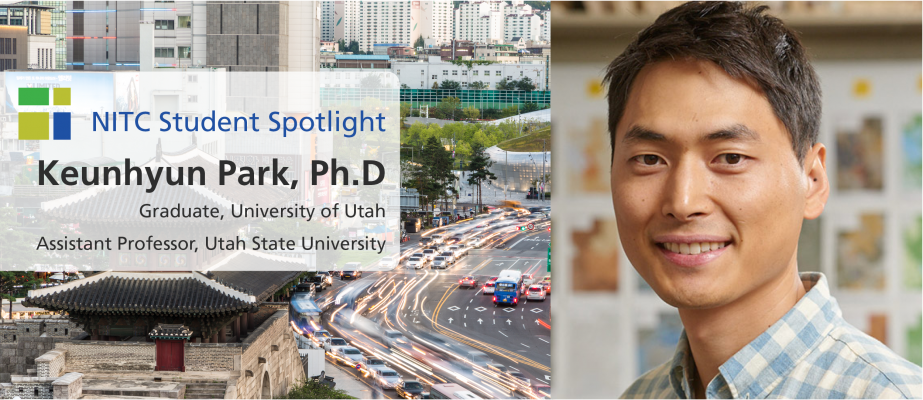Student Spotlight: Keunhyun Park, Utah State University

Keunhyun Park, Assistant Professor at Utah State University, Department of Landscape Architecture and Environmental Planning
Keunhyun Park graduated from the University of Utah in the spring of 2018, and is now a tenure-track assistant professor at Utah State University. In January 2018 he received a TRB Best Paper Award for "Travel Behavior in TODs vs. non-TODs: Using Cluster Analysis and Propensity Score Matching (PDF)," a paper he coauthored based on a NITC-funded research project with Brenda Scheer and Reid Ewing of the University of Utah. Selection was made by the Transportation and Land Development Committee of the Transportation Research Board (TRB).
Tell us about yourself:
I am from South Korea, where I studied landscape architecture for both my undergraduate and graduate degrees. Then, I had worked as a planning researcher at a Korean national research institute, Korea Research Institute for Human Settlements (KRIHS), for four years. From 2014 to 2018, I did my Ph.D. study in Metropolitan Planning, Policy, and Design at the University of Utah, where I also worked with Reid Ewing and other researchers at the Metropolitan Research Center. Starting this August, I became an assistant professor in Landscape Architecture and Environmental Planning at Utah State University.
What and/or who has most significantly influenced your path in transportation?
Reid Ewing and his book, Measuring Urban Design: Metrics for Livable Places, were some of the key factors of why I applied to the University of Utah. Working with Reid, I have been exposed to many research projects and research methods in transportation, such as statistical modeling, spatial econometrics, and quasi-experimental research. One more thing was the TRB Annual Meetings, where I found a key idea of my dissertation, usability of drones (or UAVs) in direct observation of people in public spaces.
How did your student experiences at the University of Utah and involvement in NITC-funded research impact you?
Like most international students, I had a hard time in my first Ph.D. year when I had just come to the U.S. There were language problems, unfamiliar academic vocabulary, and a different classroom culture, to name a few. At that time, I’d never imaged myself as being a teacher. But thanks to the active learning environments at the U of U and enthusiastic teachers, I was able to change my whole view of teaching. This made me change my career goal: to teach and research at a university. Also, the NITC-funded research had a crucial role in my experience at the U of U. I've participated in the entire process of projects including proposal writing. It was very helpful for me to improve grant writing skills and understand how a research project works in the university setting. Last but not least, I wouldn't have been able to finish my degree without research assistantships funded by NITC.
What do you hope to accomplish now that you're in a tenure-track position at Utah State?
Given my role statement at Utah State, I want to be excellent in research and teaching. My main research agenda is the drone-based direct observation of people in public space. Aligning with my research experience at the U of U and with NITC, I will also keep working on (transportation- and health-related) behavioral outcomes of smart growth. I will keep pursuing ongoing collaborations with NITC researchers, definitely including Reid.
This is an installment in a series of monthly Student Spotlights we'll be shining on students and alumni that are involved with National Institute for Transportation & Communites (NITC) universities. NITC is a university transportation consortium funded by the U.S. DOT, and is a Portland State-led partnership with the University of Oregon, Oregon Institute of Technology, University of Utah, University of Arizona, and University of Texas at Arlington.
